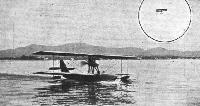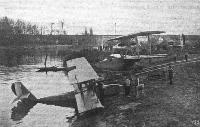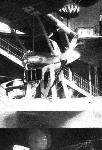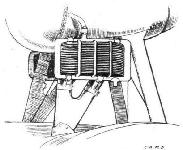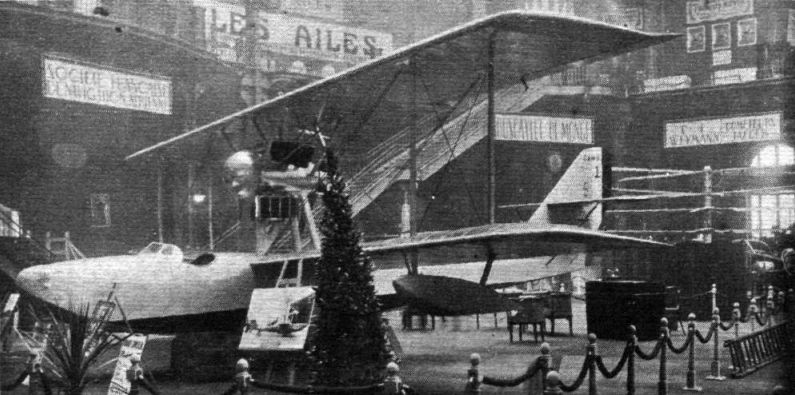
Описание
Страна : Франция
Год : 1922
Летающая лодка
Одноместный истребитель-летающая лодка
CAMS 30 и 31
Компания "Chantiers Aero-Maritimes de la Seine" (CAMS) была основана в ноябре 1920 года швейцарским инженером Д. Лоуренсом Сантони и специализировалась на разработке и постройке гидросамолетов и скоростных катеров. Первыми изделиями фирмы стали две лицензионные итальянские летающие лодки SIAI S.9 и S.13. Конструктор этих самолетов Рафаэль Конфленти в 1921 году стал техническим директором CAMS.
Первым успехом Конфленти стал самолет CAMS 30E, предназначенный для первоначальной и основной подготовки летчиков с размещением инструктора и курсанта в открытой кабине бок о бок. Летающая лодка CAMS 30 являлась равнокрылым бипланом деревянной конструкции. Чистые формы корпуса лодки характерны для всех конструкций Конфленти и напоминают очертания ранних летающих лодок SIAI. Мотор Hispano-Suiza установлен между крыльями и снабжен двухлопастным толкающим винтом, радиатор установлен над мотором.
После демонстрации в 1922 году на авиасалоне в Париже, прототип CAMS 30E в начале 1923 года был отправлен на испытания и в марте 1923 года официально передан морской авиации, а затем поступил в летную школу французских ВМС в районе города Берр. Всего для ВМС Франции были построены 22 летающие лодки, еще семь экспортировали в Югославию, где их эксплуатировали более десяти лет. На моторы серийных самолетов ставили по два радиатора (по одному с каждой стороны мотора) вместо одного радиатора, установленного на моторе прототипа.
На CAMS 30E стоял один V-образный мотор Hispano-Suiza 8Аа мощностью 150 л.с.; максимальная скорость 153 км/ч, масса пустого 885 кг, максимальная взлетная масса 1180 кг, размах крыла 12,40 м, длина 9,28 м, высота 3,12 м, площадь крыла 43,00 мг.
Весной 1923 года был построен один CAMS 30Т в четырехместном туристском варианте, в августе 1924 года на нем Эрнест Барри установил рекорд скорости для пассажирских гидросамолетов.
Одним из самых необычных самолетов фирмы стал CAMS 31, единственный гидроплан-истребитель марки CAMS. Одноместный равнокрылый биплан имел деревянную конструкцию и два стабилизирующих поплавка, смонтированных на концах нижнего крыла. Хвостовое оперение традиционное, с расчалками. Мотор Hispano-Suiza установлен между крыльями в мотогондоле на N-образных стойках, закрепленных на корпусе. Мотор снабжен двухлопастным толкающим винтом. Открытая кабина пилота расположена чуть впереди нижнего крыла, вооружение в виде двух неподвижных пулеметов смонтировано в корпусе. Первый полет прототип выполнил в конце 1922 года, позже он получил обозначение CAMS 31 Type 22, а второй прототип, выполнивший первый полет в 1923 году, обозначался CAMS 31 Type 23. Размах крыльев на втором прототипе уменьшили, но увеличили их хорду, при этом площадь осталась неизменной. Хотя оба прототипа обладали хорошей управляемостью, их летные данные и маневренность как истребителя оставляли желать лучшего, поэтому решения о начале серийного производства не последовало.
ТАКТИКО-ТЕХНИЧЕСКИЕ ХАРАКТЕРИСТИКИ
CAMS 31 Type 22
Тип: одноместный истребитель-летающая лодка
Силовая установка: один V-образный мотор Hispano-Suiza 8Fb мощностью 300 л. с. (224 кВт)
Летные характеристики: максимальная скорость на уровне моря 200 км/ч; время набора высоты 1000 м - 3 мин; дальность 400 км
Масса: пустого 1045 кг; максимальная взлетная 1505 кг
Размеры: размах крыла 11,20 м; длина 8,80 м; высота 3,05 м; площадь крыла 33,00 м2
Вооружение: два неподвижных 7,7-мм пулемета Vickers в носовой части корпуса
Описание:
- CAMS 30 и 31
- Flight, December 1922
THE PARIS AERO SHOW 1922 - Flight, July 1923
LES CHANTIERS AERO-MARITIMES DE LA SEINE
Фотографии
-
Flight 1922-12 / Flight
C.A.M.S. side-by-side flying boat for school work.
-
Flight 1923-07 / Flight
THE C.A.M.S. 30 E TAXYING OFF ST. RAPHAEL: This machine is a side-by-side two-seater flying-boat intended for school work. Note how the hollow step formation of the bottom of the hull results in pushing up a bow wave, without the spray thrown up by V-bottom types.
-
Flight 1923-07 / Flight
TWO C.A.M.S. FLYING BOATS: In the foreground the type 31 single-seater fighter. Note the machine gun scoops in the deck. On the right, the experimental twin-engined commercial machine, type 33, in which the Hispano engines are placed tandem fashion.
Другие самолёты на фотографии: CAMS CAMS 33 - Франция - 1923
-
Мировая Авиация 80
Одноместный биплан CAMS 31 предназначался для использования в качестве истребителя, но неудовлетворительные летные данные и плохая маневренность не оставляли самолету шансов на успех в воздушном бою.
-
Aeroplane Monthly 1980-08 / H.Crowte - The CAMS flying boats (1)
One of the earliest designs was the Type 32, a two-seater with accommodation for a gunner in the bows.
-
Flight 1922-12 / Flight
The neat engine mounting and cowling of the C.A.M.S. flying boat.
-
Flight 1922-12 / Flight
Sketch showing the small Botali radiators on the C.A.M.S. flying boat.
-
Flight 1922-12 / Flight
C.A.M.S. 30.E
- Фотографии


